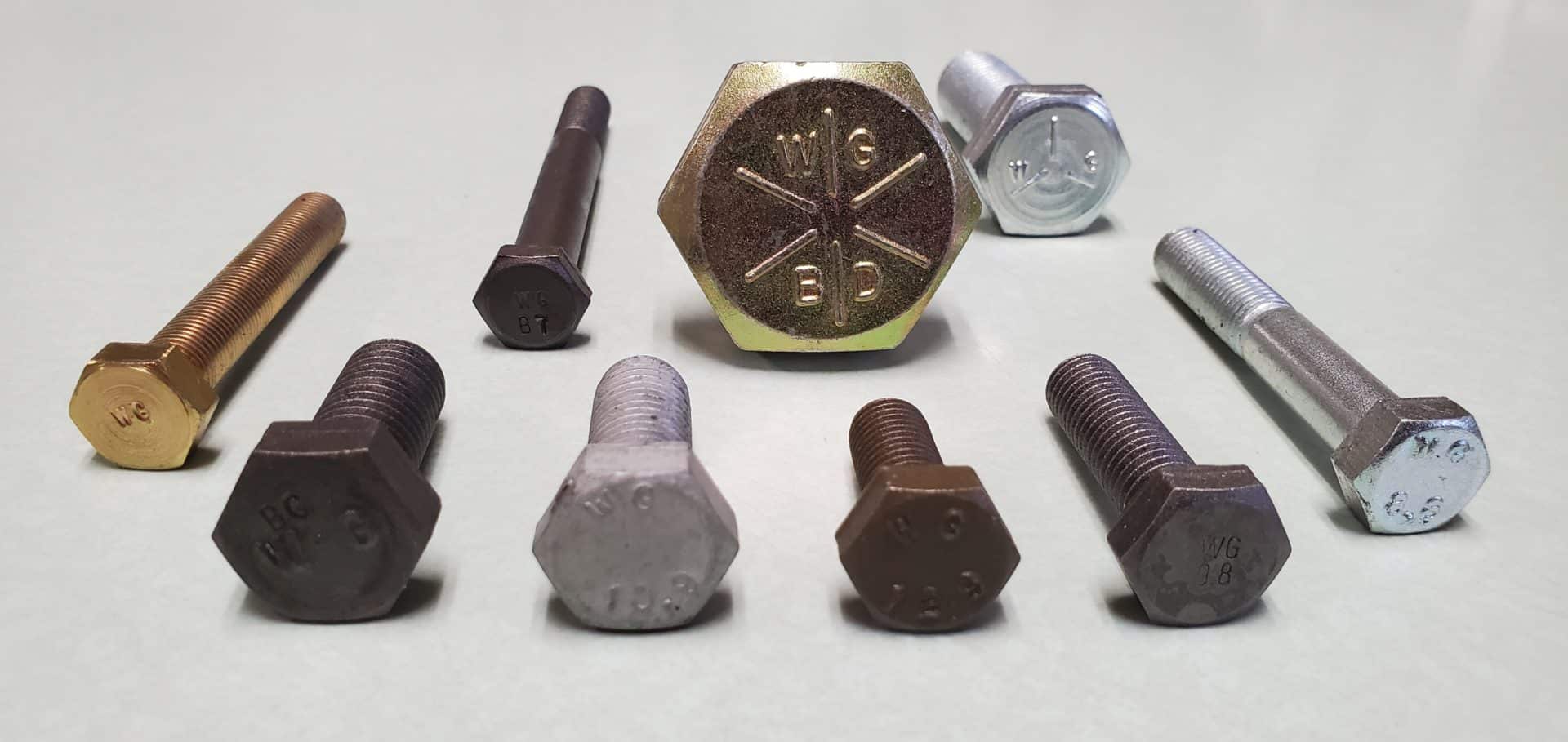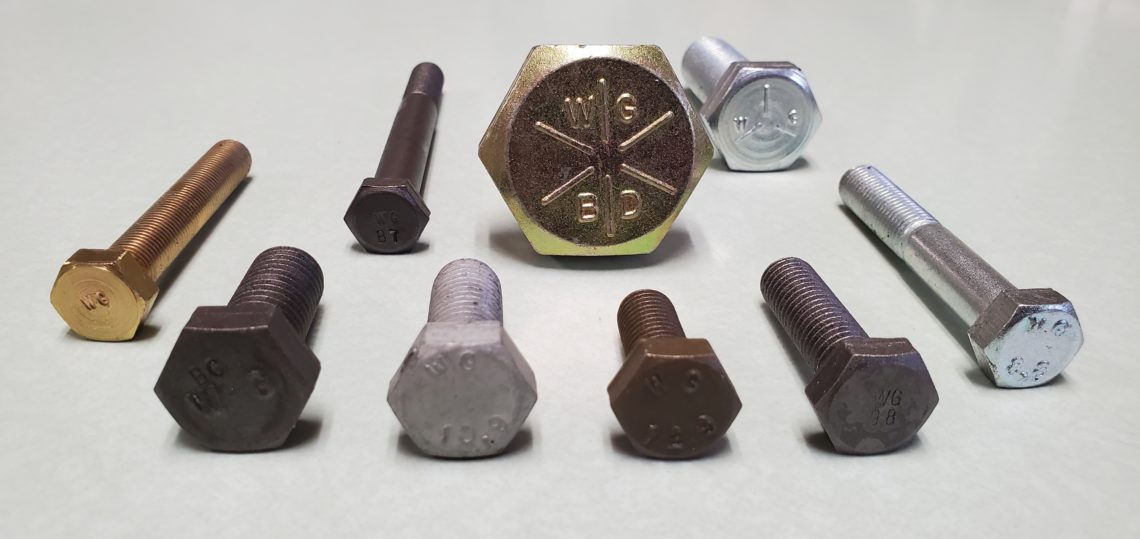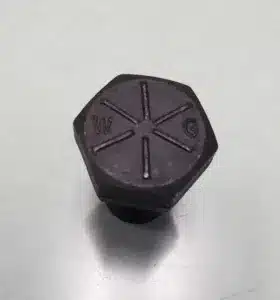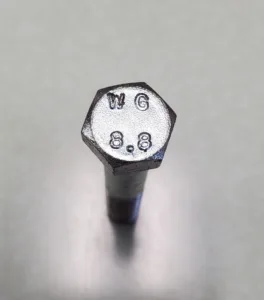We’ve discussed bolt grades in some of our past articles. However, like many topics in the fastener industry, they can be a bit tricky to fully understand. We explain what bolts grades are, how they’re categorized, and what some of their uses are below. That way, you’ll hopefully gain a better idea of what bolt grade you need for your application.
Bolt Grades Explained
Bolt grades are defined by their specific material, as well as the strength of that material. This helps to determine the maximum amount of stress that the bolt can handle. Typically, a bolt grade spec will call out the material (or give a couple of material options), then list the strength requirements for that material.
If you’re working with carbon or alloy steel bolts (which are the most common), these strength requirements are determined by the hardness requirements for that material. The harder the material, the higher the bolt strength. Many specs may also have proof load or tensile strength requirements, but these are really just a confirmation of the strength that’s called out in the hardness requirements.
Overall, bolt grades are useful to be aware of when you’re deciding which kind of bolt you need for your particular application.
3 Governing Bodies That Create Bolt Grading Standards
SAE, ISO, and ASTM are three of the main governing bodies that create standards to set the rules for bolt grading systems. While there are many other governing bodies, each with their own long list of grading standards, we’re sticking to these three as examples in this article. They’re of the most common we deal with here at Wilson-Garner, but that’s not necessarily the case for every manufacturer.
Each of these systems have their own standards and naming conventions, but they generally follow the same rule for bolt grades — the higher the grade, the stronger the bolt. If you’re unsure about the grade or material of a particular bolt, looking at its head is a good place to start, as most standards define head marking requirements for most grades.
SAE
SAE stands for the Society of Automotive Engineers. Its standards are one of the most common for inch parts. SAE J429 is the standard developed for bolt, screw, stud, sem, and U-bolt specifications.
For bolts, you can find the SAE J429 grade displayed in radial lines on the head, which indicate the grade and strength requirements.
More on SAE J429 grades, specifications, and head markings here.
ISO/Metric
ISO stands for the International Standards Organization. ISO 898-1 is the most commonly used standard for metric grades, or property classes (the technically correct terminology for metric bolt grades). It dictates the standard for bolts, screws, and studs made from carbon steel and alloy steel. It includes 10 different property classes.
For bolts, you can find the ISO 898-1 property class displayed in raised or depressed numbers on its head.
More on ISO property classes, specifications, and head markings here.
ASTM
ASTM stands for the American Society for Testing and Materials. ASTM A307 is the standard developed for bolts and studs, and it creates two different grades: Grade A and Grade B. You’ll find the grade listed as 307A or 307B on the bolt head.
More on ASTM A307 grades, specifications, and head markings here.
Different Bolts Grades and Their Applications
Now let’s jump into some specific bolt grades and their applications. But first, let us say that there are many different bolt grades out there. For the sake of brevity, we’ll just be discussing a few of the most common bolt grades within each of the systems listed above.
SAE J429
- SAE J429 Grade 2 – For bolts made of low- to medium-strength carbon steel, this is the SAE J429 grade that requires the least amount of strength, between 60,000-74,000 psi. Therefore, these bolts are used for non-critical joints and applications. Contractors, designers, OEMs, and maintenance crews use them because they work for generic applications that aren’t exposed to extreme stress or temperatures, and they’re the most affordable.
- SAE J429 Grade 5 – For bolts made of medium-strength carbon or alloy steel, this grade has strength requirements that fall in the middle range, from 105,000-120,000 psi. They’re commonly used in military and heavy machinery applications, as they’re able to withstand quite a bit of stress.
- SAE J429 Grade 8 – For bolts made of medium-strength carbon or alloy steel, this grade offers the highest level of strength, up to 150,000 psi. Therefore, it’s used in applications with the most rugged, extreme conditions, such as military, heavy machinery, and aerospace engineering.
ISO 898-1
- ISO 898-1 Property Class 8.8 – This property class offers medium strength, and is comparable to SAE J429 Grade 5. Therefore, their applications are similar, including military and heavy machinery — but they’re also very commonly used in the automotive industry.
- ISO 898-1 Property Class 10.9 – This property class offers high strength, and is comparable to SAE J429 Grade 8. Therefore, 10.9 bolts also have the same common applications: military, heavy machinery, and aerospace.
- ISO 898-1 Property Class 12.9 – This property class offers some of the highest strength available. In fact, these are the strongest bolts we make here at Wilson-Garner. They’re used in critical applications like securing engine parts and motor casings.
ASTM A307
- ASTM A307 Grade A – As low- to medium-strength carbon steel bolts, Grade A bolts offer a minimum strength of 60,000 psi. They’re used for general, non-critical applications, and are comparable to SAE J429 Grade 2 bolts.
- ASTM A307 Grade B – As medium-strength carbon steel bolts, Grade B bolts offer a little more strength, between 60,000-100,000 psi. They’re commonly used in flanged joints in piping systems.
RELATED: Need a specialty bolt, screw, or stud? Wilson-Garner can help.
Stainless Steel & Titanium Bolt Grades
We should also mention that each of the system and bolt grades listed above are for bolts made of carbon or alloy steel. However, there are also many bolt grades for other materials, like stainless steel or titanium.
For example, some stainless steel and titanium bolt grades include:
Stainless Steel
- 304 – Commercial grade, 74,000 psi
- 316 – Marine grade, 180,000 psi
Titanium
- Grade 2 – Commercial grade, 50,000 psi
- Grade 5 – High-strength, 138,000 psi
While we don’t work with these materials at Wilson-Garner, we’re happy to try and answer any questions you have about them or direct you to a solution that might work better for your application.
Not sure which bolt grade is right for your application? Talk to the team at Wilson-Garner! Our specialty fastener experts can help you determine the best solution, then manufacture parts that fit your specifications in limited-run quantities. If you have any questions, feel free to reach out via phone call or our online contact form.





Comments are closed.